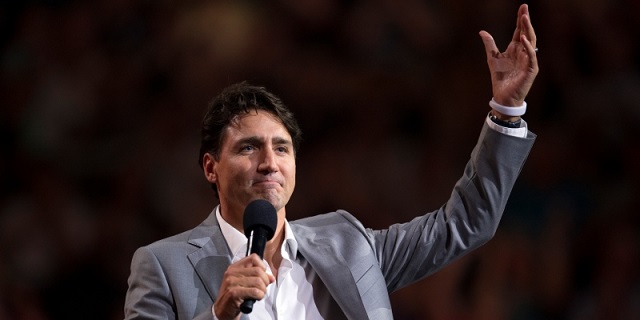Economy
Federal government’s recent fiscal record includes unprecedented levels of spending and debt

From the Fraser Institute
By Jake Fuss and Grady Munro
As of 2024, Ottawa’s debt equals $51,467 per Canadian—12.3 per cent more than in 1995 when Canada reached a near-debt crisis.
According to an Angus Reid poll from earlier this year, 59 per cent of Canadians believe the federal government is spending too much and 64 per cent said they’re concerned about the size of the budget deficit. Nanos Research had similar polling results, finding 63 per cent of Canadians want Ottawa to reduce spending. These polling results are not surprising given the alarming state of federal finances.
The Trudeau government has consistently spent at record-high levels before, during and after COVID. In fact, Prime Minister Trudeau is on track to record the seven-highest years of per-person spending in Canadian history between 2018 and 2024. Inflation-adjusted spending (excluding debt interest costs) is expected to reach $11,856 per person this year—10.2 per cent higher than during the 2008-09 financial crisis and 28.7 per cent higher than during the peak of the Second World War.
Consequently, the Trudeau government has posted 10 consecutive deficits since taking office. The projected deficit in 2024/25 is a whopping $39.8 billion. This string of deficits has spurred a dramatic increase in federal debt. From 2014/15 (Prime Minister Harper’s last full year) to 2024/25, total federal debt is expected to have nearly doubled to $2.1 trillion. To make matters worse, the government plans to run more deficits until at least 2028/29 and total debt could rise by an additional $400.1 billion by March 2029.
Indeed, due to reckless decisions, the Trudeau government is on track to record the five-highest years of per-person debt (inflation-adjusted) in Canadian history between 2020 and 2024. As of 2024, Ottawa’s debt equals $51,467 per Canadian—12.3 per cent more than in 1995 when Canada reached a near-debt crisis.
Worse still, that doesn’t include any provincial or municipal debt, so the total government debt burden per Canadian is considerably higher.
Of course, to pay for this sky-high spending, the Trudeau government has borrowed and raised taxes. In addition to recently raising taxes on capital gains—harming entrepreneurship, investment and growth—the government has raised personal income taxes on middle-income families. Today, 86 per cent of middle-income Canadian families pay more in taxes than they did in 2015.
And what has this combination of tax increases and record-high spending and debt delivered for Canadians?
Amid widespread concerns about the rising cost of living, the average Canadian family is spending more on taxes than on food, shelter and clothing combined. Despite a recent federal budget supposedly focused on “fairness for every generation,” younger generations face a disproportionately higher tax burden in the future due to debt accumulated today. Meanwhile, Canadian living standards (as measured by inflation-adjusted GDP per person) are in a historic decline and (as of June 2024) stood 3.2 per cent below 2019 levels.
The current state of federal finances is simply unacceptable. Ottawa can and must do better. Canadians are already feeling the consequences, and it will only continue to get worse for future generations if we don’t constrain spending and return to balanced budgets soon.
Authors:
Business
Most Canadians say retaliatory tariffs on American goods contribute to raising the price of essential goods at home

- 77 per cent say Canada’s tariffs on U.S. products increase the price of consumer goods
- 72 per cent say that their current tax bill hurts their standard of living
A new MEI-Ipsos poll published this morning reveals a clear disconnect between Ottawa’s high-tax, high-spending approach and Canadians’ level of satisfaction.
“Canadians are not on board with Ottawa’s fiscal path,” says Samantha Dagres, communications manager at the MEI. “From housing to trade policy, Canadians feel they’re being squeezed by a government that is increasingly an impediment to their standard of living.”
More than half of Canadians (54 per cent) say Ottawa is spending too much, while only six per cent think it is spending too little.
A majority (54 per cent) also do not believe federal dollars are being effectively allocated to address Canada’s most important issues, and a similar proportion (55 per cent) are dissatisfied with the transparency and accountability in the government’s spending practices.
As for their own tax bills, Canadians are equally skeptical. Two-thirds (67 per cent) say they pay too much income tax, and about half say they do not receive good value in return.
Provincial governments fared even worse. A majority of Canadians say they receive poor value for the taxes they pay provincially. In Quebec, nearly two-thirds (64 per cent) of respondents say they are not getting their money’s worth from the provincial government.
Not coincidentally, Quebecers face the highest marginal tax rates in North America.
On the question of Canada’s response to the U.S. trade dispute, nearly eight in 10 Canadians (77 per cent) agree that Ottawa’s retaliatory tariffs on American products are driving up the cost of everyday goods.
“Canadians understand that tariffs are just another form of taxation, and that they are the ones footing the bill for any political posturing,” adds Ms. Dagres. “Ottawa should favour unilateral tariff reduction and increased trade with other nations, as opposed to retaliatory tariffs that heap more costs onto Canadian consumers and businesses.”
On the issue of housing, 74 per cent of respondents believe that taxes on new construction contribute directly to unaffordability.
All of this dissatisfaction culminates in 72 per cent of Canadians saying their overall tax burden is reducing their standard of living.
“Taxpayers are not just ATMs for government – and if they are going to pay such exorbitant taxes, you’d think the least they could expect is good service in return,” says Ms. Dagres. “Canadians are increasingly distrustful of a government that believes every problem can be solved with higher taxes.”
A sample of 1,020 Canadians 18 years of age and older was polled between June 17 and 23, 2025. The results are accurate to within ± 3.8 percentage points, 19 times out of 20.
The results of the MEI-Ipsos poll are available here.
* * *
The MEI is an independent public policy think tank with offices in Montreal, Ottawa, and Calgary. Through its publications, media appearances, and advisory services to policymakers, the MEI stimulates public policy debate and reforms based on sound economics and entrepreneurship.
Business
Trump confirms 35% tariff on Canada, warns more could come

Quick Hit:
President Trump on Thursday confirmed a sweeping new 35% tariff on Canadian imports starting August 1, citing Canada’s failure to curb fentanyl trafficking and retaliatory trade actions.
Key Details:
- In a letter to Canadian Prime Minister Mark Carney, Trump said the new 35% levy is in response to Canada’s “financial retaliation” and its inability to stop fentanyl from reaching the U.S.
- Trump emphasized that Canadian businesses that relocate manufacturing to the U.S. will be exempt and promised expedited approvals for such moves.
- The administration has already notified 23 countries of impending tariffs following the expiration of a 90-day negotiation window under Trump’s “Liberation Day” trade policy.
Diving Deeper:
President Trump escalated his tariff strategy on Thursday, formally announcing a 35% duty on all Canadian imports effective August 1. The move follows what Trump described as a breakdown in trade cooperation and a failure by Canada to address its role in the U.S. fentanyl crisis.
“It is a Great Honor for me to send you this letter in that it demonstrates the strength and commitment of our Trading Relationship,” Trump wrote to Prime Minister Mark Carney. He added that the tariff response comes after Canada “financially retaliated” against the U.S. rather than working to resolve the flow of fentanyl across the northern border.
Trump’s letter made clear the tariff will apply broadly, separate from any existing sector-specific levies, and included a warning that “goods transshipped to evade this higher Tariff will be subject to that higher Tariff.” The president also hinted that further retaliation from Canada could push rates even higher.
However, Trump left the door open for possible revisions. “If Canada works with me to stop the flow of Fentanyl, we will, perhaps, consider an adjustment to this letter,” he said, adding that tariffs “may be modified, upward or downward, depending on our relationship.”
Canadian companies that move operations to the U.S. would be exempt, Trump said, noting his administration “will do everything possible to get approvals quickly, professionally, and routinely — In other words, in a matter of weeks.”
The U.S. traded over $762 billion in goods with Canada in 2024, with a trade deficit of $63.3 billion, a figure Trump called a “major threat” to both the economy and national security.
Speaking with NBC News on Thursday, Trump suggested even broader tariff hikes are coming, floating the idea of a 15% or 20% blanket rate on all imports. “We’re just going to say all of the remaining countries are going to pay,” he told Meet the Press moderator Kristen Welker, adding that “the tariffs have been very well-received” and noting that the stock market had hit new highs that day.
The Canadian announcement is part of a broader global tariff rollout. In recent days, Trump has notified at least 23 countries of new levies and revealed a separate 50% tariff on copper imports.
“Not everybody has to get a letter,” Trump said when asked if other leaders would be formally notified. “You know that. We’re just setting our tariffs.”
-

 espionage1 day ago
espionage1 day agoFBI’s Dan Bongino may resign after dispute about Epstein files with Pam Bondi
-

 Business2 days ago
Business2 days agoCBC six-figure salaries soar
-

 Addictions2 days ago
Addictions2 days agoCan addiction be predicted—and prevented?
-

 International2 days ago
International2 days agoSupport for the Ukraine war continues because no one elected is actually in charge.
-

 Business2 days ago
Business2 days agoTrump slaps Brazil with tariffs over social media censorship
-

 National1 day ago
National1 day agoHow Long Will Mark Carney’s Post-Election Honeymoon Last? – Michelle Rempel Garner
-

 Addictions2 days ago
Addictions2 days agoMore young men want to restrict pornography: survey
-

 Brownstone Institute2 days ago
Brownstone Institute2 days agoNet Zero: The Mystery of the Falling Fertility









